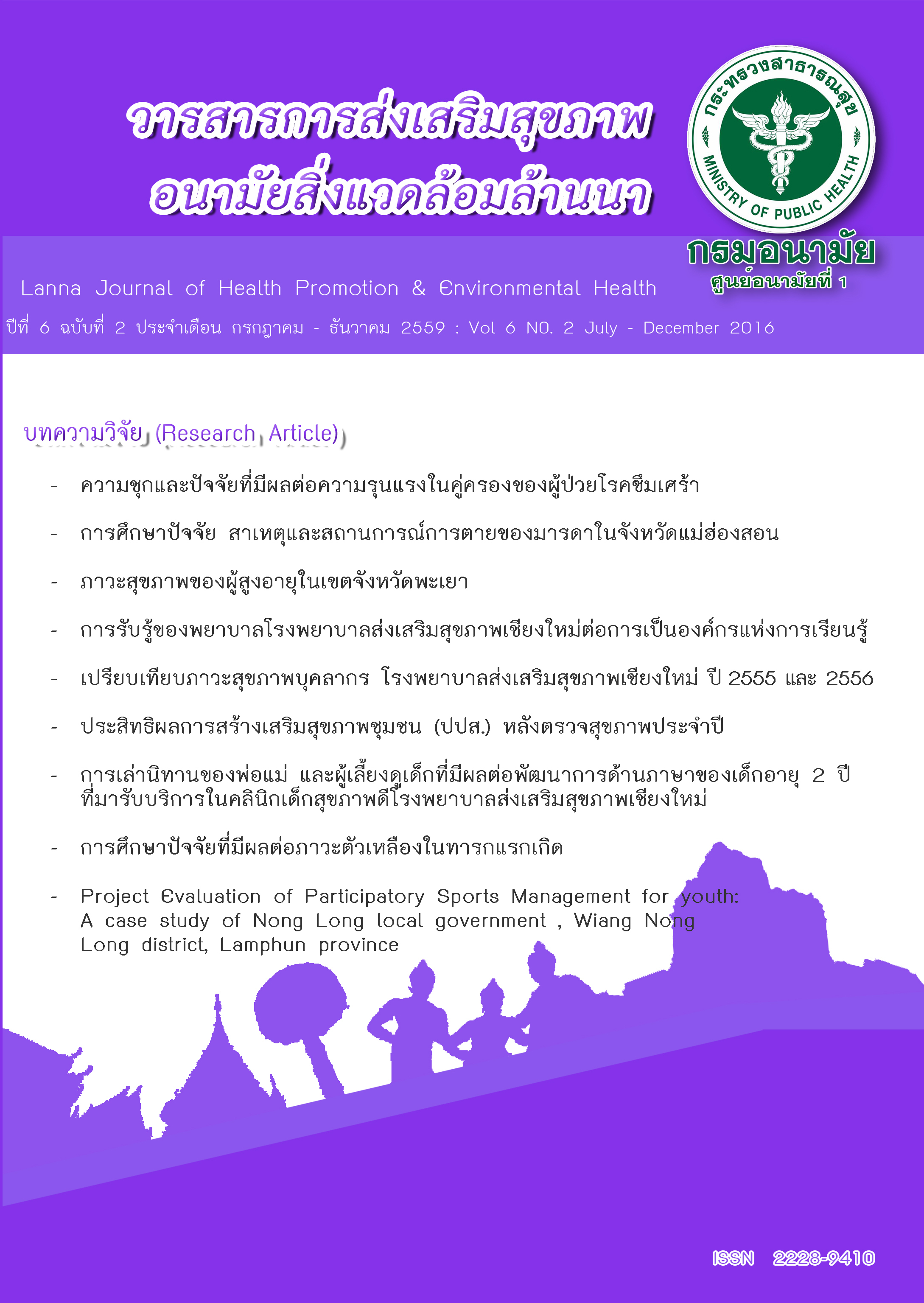ความชุกและปัจจัยที่มีผลต่อความรุนแรงในคู่ครองของผู้ป่วยโรคซึมเศร้า
คำสำคัญ:
ความรุนแรงในคู่ครอง ผู้ป่วยโรคซึมเศร้าบทคัดย่อ
วัตถุประสงค์: เพื่อศึกษาความชุกและปัจจัยที่มีผลต่อความรุนแรงในคู่ครองของผู้ป่วยโรคซึมเศร้า
วิธีการวิจัย: รูปแบบการวิจัยเป็นแบบเชิงวิเคราะห์ cross-sectional study โดยทำการศึกษาในผู้ป่วยโรคซึมเศร้าที่มารับการตรวจรักษาที่โรงพยาบาลสันป่าตอง จำนวน 175 คน และได้ทำการเก็บข้อมูลโดยใช้แบบสอบถาม
ผลการศึกษา: ผู้ป่วยที่มีความรุนแรงในคู่ครองมีคะแนนเฉลี่ย Hits Questionnaire เท่ากับ 14.11 คะแนน มีอายุเฉลี่ย 47.56 ปี เป็นเพศหญิง 88.89% จบการศึกษาชั้นประถมศึกษา 88.89% ไม่ได้ประกอบอาชีพ 22.22% ดื่มสุรา 33.33% ใช้ยาเสพติด 22.22% และมีโรคประจำตัวทางกาย 22.22% มีอายุคู่ครองเฉลี่ย 49.22 ปี เป็นคู่ครองเพศชาย 88.89% คู่ครองจบการศึกษาชั้นประถมศึกษา 66.67% คู่ครองประกอบอาชีพธุรกิจส่วนตัว/ค้าขาย 44.44% คู่ครองดื่มสุรา 88.89% คู่ครองใช้ยาเสพติด 55.56% คู่ครองชอบหึงหวง 77.78% รายได้ในครอบครัวไม่เพียงพอ 77.78% ความสัมพันธ์ในชีวิตคู่ไม่ดี 100%
สรุป : ความชุกของความรุนแรงในคู่ครองของผู้ป่วยโรคซึมเศร้าเท่ากับ 25.7% ส่วนปัจจัยที่มีผลต่อความรุนแรงในคู่ครองของผู้ป่วยโรคซึมเศร้าได้แก่ อายุ เพศ การศึกษา อาชีพ การดื่มสุรา การใช้ยาเสพติด การมีโรคประจำตัวทางกายของผู้ป่วย เพศคู่ครอง การศึกษาคู่ครอง อาชีพคู่ครอง คู่ครองดื่มสุรา คู่ครองใช้ยาเสพติด คู่ครองชอบ หึงหวง ความเพียงพอของรายได้ในครอบครัว และความสัมพันธ์ในชีวิตคู่ (P<0.05)
เอกสารอ้างอิง
2. Christie-Seely J(Ed). Working with the family in primary care: a systems approach to health and illness. Westport, Connecticut: Praeger. 1984. p. 449-487
3. Hamberger LK, Renzetti C(Ed). Domestic Partner Abuse. New York: Springer. 1996.
4. McDaniel S, Campbell TL, and Seaburn DB. Family-Oriented Primary Care: A manual for medical providers. Springer : New York 1990. p. 89-104, 168-187
5. Talbot Y, Norman P. Your Toolkit for Counseling Couples. Patient Care Canada 1997;3(10):65-75Taylor RB(Ed.). Fundamentals of Family Medicine: The family medicine clerkship textbook. 3rd Ed.New York : Springer. 2003. p.133-147.
6. Walker Leonore, E. The battered women, New York, Harper and Row, 1979.
7. Colleen T. Fogarty, MD; Sandra Burge, PhD; Elizabeth C. McCord, MD., Communicating With Patients About Intimate Partner Violence: Screening and Interviewing Approaches. Am Fam Physician. 1996 Jun;53(8):2575-80, 2582
8. Neufeld B., SAFE questions: overcoming barriers to the detection of domestic violence. Am Fam Physician. 1996 Jun;53(8):2575-80, 2582.
9. Brown JB, LentB,Bratt PJ, Sas G, Pederson LL. Development of the Woman Abuse Screening Tool for use in family practice. Fam Med 1996;28(6):422-8.
10. Gina Dillon, Rafat Hussain, Deborah Loxton, et al. Mental and Physical Health and Intimate Partner Violence against Women: A Review of the Literature. International Journal of Family Medicine 2013 :Article ID 313909, 15 pages
11. Ann L Coker, Keith E Davis,Ileana Arias, et al. Physical and mental health effects of intimate partner violence for men and women. American Journal of Preventive Medicine 2002;23(4):260-268
12. N Thananowan. Prevalence and Factors Related to Intimate Partner Violence among Gynecology Patients. Journal of nursing scince 2013;31(3):37-47
13. N Thananowan, P Kaesornsamut. Factors Predicting Intimate Partner Violence among Women with Gynecological Problems. Journal of nursing scince 2014;32(1)
14. M Chuemchit, U Perngparn. Intimate Partner Violence: Thailand Situation and Intervention Programme. International Journal of Social Science and Humanity 2014; 4(4)






